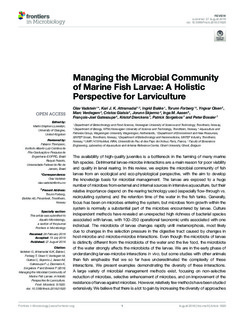| dc.contributor.author | Vadstein, Olav | |
| dc.contributor.author | Attramadal, Kari | |
| dc.contributor.author | Bakke, Ingrid | |
| dc.contributor.author | Forberg, Torunn | |
| dc.contributor.author | Olsen, Yngvar | |
| dc.contributor.author | Verdegem, Marc | |
| dc.contributor.author | Giatsis, C. | |
| dc.contributor.author | Skjermo, Jorunn | |
| dc.contributor.author | Aasen, Inga Marie | |
| dc.contributor.author | Gatesoupe, Francois-Joel | |
| dc.contributor.author | Dirckens, Kristof | |
| dc.contributor.author | Sorgeloos, Patrick | |
| dc.contributor.author | Bossier, Peter | |
| dc.date.accessioned | 2018-09-05T06:56:57Z | |
| dc.date.available | 2018-09-05T06:56:57Z | |
| dc.date.created | 2018-09-04T15:46:06Z | |
| dc.date.issued | 2018 | |
| dc.identifier.citation | Frontiers in Microbiology. 2018, 9 (1820), . | nb_NO |
| dc.identifier.issn | 1664-302X | |
| dc.identifier.uri | http://hdl.handle.net/11250/2560808 | |
| dc.description.abstract | The availability of high-quality juveniles is a bottleneck in the farming of many marine fish species. Detrimental larvae-microbe interactions are a main reason for poor viability and quality in larval rearing. In this review, we explore the microbial community of fish larvae from an ecological and eco-physiological perspective, with the aim to develop the knowledge basis for microbial management. The larvae are exposed to a huge number of microbes from external and internal sources in intensive aquaculture, but their relative importance depend on the rearing technology used (especially flow-through vs. recirculating systems) and the retention time of the water in the fish tanks. Generally, focus has been on microbes entering the system, but microbes from growth within the system is normally a substantial part of the microbes encountered by larvae. Culture independent methods have revealed an unexpected high richness of bacterial species associated with larvae, with 100–250 operational taxonomic units associated with one individual. The microbiota of larvae changes rapidly until metamorphosis, most likely due to changes in the selection pressure in the digestive tract caused by changes in host-microbe and microbe-microbe interactions. Even though the microbiota of larvae is distinctly different from the microbiota of the water and the live food, the microbiota of the water strongly affects the microbiota of the larvae. We are in the early phase of understanding larvae-microbe interactions in vivo, but some studies with other animals than fish emphasize that we so far have underestimated the complexity of these interactions. We present examples demonstrating the diversity of these interactions. A large variety of microbial management methods exist, focusing on non-selective reduction of microbes, selective enhancement of microbes, and on improvement of the resistance of larvae against microbes. However, relatively few methods have been studied extensively. We believe that there is a lot to gain by increasing the diversity of approaches for microbial management. As many microbial management methods are perturbations of the microbial community, we argue that ecological theory is needed to foresee and test for longer term consequences in microbe-microbe and microbe-larvae interactions. We finally make some recommendations for future research and development. | nb_NO |
| dc.language.iso | eng | nb_NO |
| dc.publisher | Frontiers Media | nb_NO |
| dc.rights | Navngivelse 4.0 Internasjonal | * |
| dc.rights.uri | http://creativecommons.org/licenses/by/4.0/deed.no | * |
| dc.title | Managing the microbial community of marine fish larvae: a holistic perspective for larviculture | nb_NO |
| dc.type | Journal article | nb_NO |
| dc.type | Peer reviewed | nb_NO |
| dc.description.version | publishedVersion | nb_NO |
| dc.source.pagenumber | 22 | nb_NO |
| dc.source.volume | 9 | nb_NO |
| dc.source.journal | Frontiers in Microbiology | nb_NO |
| dc.source.issue | 1820 | nb_NO |
| dc.identifier.doi | 10.3389/fmicb.2018.01820 | |
| dc.identifier.cristin | 1606691 | |
| dc.description.localcode | Copyright © 2018 Vadstein, Attramadal, Bakke, Forberg, Olsen, Verdegem, Giatsis, Skjermo, Aasen, Gatesoupe, Dierckens, Sorgeloos and Bossier. This is an open-access article distributed under the terms of the Creative Commons Attribution License (CC BY). | nb_NO |
| cristin.unitcode | 194,66,15,0 | |
| cristin.unitcode | 194,66,10,0 | |
| cristin.unitname | Institutt for bioteknologi og matvitenskap | |
| cristin.unitname | Institutt for biologi | |
| cristin.ispublished | true | |
| cristin.fulltext | original | |
| cristin.qualitycode | 1 | |

